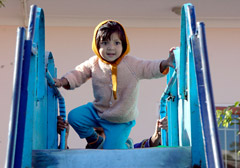 It’s January sixth and we’re on our way to Haridwar, one of India‘s holiest cities in the northern state of Uttar Pradesh. Theoretically, it’s a 6 hour drive from Delhi, but as we’ve learned, the (bumpy) realities of the roads probably mean this trip will take 10 hours or so, maybe longer. (In fact, as I look at my watch, we’ve been on the bus 5.5 hours and we’re only half way there! But, as Chris has already stated, the journey is the destination!)
It’s January sixth and we’re on our way to Haridwar, one of India‘s holiest cities in the northern state of Uttar Pradesh. Theoretically, it’s a 6 hour drive from Delhi, but as we’ve learned, the (bumpy) realities of the roads probably mean this trip will take 10 hours or so, maybe longer. (In fact, as I look at my watch, we’ve been on the bus 5.5 hours and we’re only half way there! But, as Chris has already stated, the journey is the destination!)
Over the past few days it seems almost everyone has developed a cold. A few folks have had various stages of Delhi belly, too. Luckily, while we all could feel much better, we’re troopers and almost everyone has been able to join in our field trips to the Ganges, embroidery factory, Sarnath (site of the Buddha’s first sermon), and on a cyclo-rickshaw tour through Varanasi which was pretty mind-blowing and which offered a very different perspective on Varanasi street life than we would ever get from our elevated tour bus.
 |  |
I continue to be wowed by the students who, although tired and somewhat sick, are still eager and willing to carve out 20 minutes here and there as we can to talk about our course materials. Lately, most of our discussions have dealt with the ethics of our field. What is our role as visual sociologists? How and what can/should we document and what is the best route to accomplish our task. Should we be neutral observers? When, if ever, should our goal be to persuade? When, if ever, should we intervene in the scene? How do we rectify our sometimes conflicting roles of the individual and the researcher? For example, we talked about who did and who did not take photos of Banu, the seriously disabled child at Mother Theresa’s orphanage. How did students come to make those decisions? Some chose not to take Banu’s picture since they could not be sure of his consent. Others had ‘conversations’ with Banu in which he was not only responsive, but joyous. And, they felt, it was important to photograph him to ensure he was given equal treatment as the other children. This situation is representative of others we’ve encountered as we’ve entered into people’s lives here, if only in passing. Do you take the photo of the hungry child? What is your motivation or intention in doing so? What do we hope is gained by having/sharing such an image? Does the photo commodify the child? Or, is it merely documentation of a social reality? How do we portray the difficulties of the poor AND their dignity, strength, and beauty (much as Dorothea Lange was able to do with her migrant photos during the depression)?
One of the students’ guided journal questions a few days ago asked them to reflect on the quote from famed photographer, Robert Doisneau, who said: ‘It’s better, isn’t it, to shed some light on those people who are never in the limelight?’ These are important questions they are considering. There are no easy answers. No clear cut solutions. But the fact that they are grappling with these issues speaks volumes about who they are.
